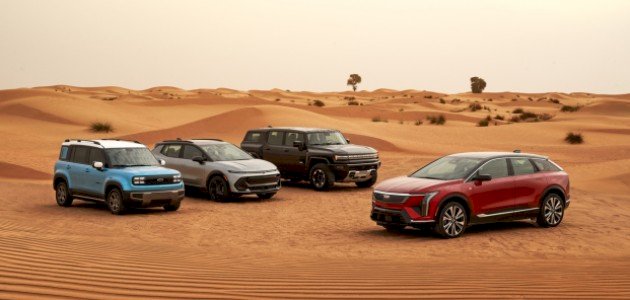 Share
Share

It is essential to emphasize a fundamental point: the adoption of electric vehicles (EVs) is a central component of this approach—helping reduce greenhouse gas emissions, decrease reliance on fossil fuels, and reshape the urban energy landscape. With investments in the billions from both public and private sectors already underway, the transition to electric vehicles is accelerating rapidly!
Within this context, General Motors, with its extensive regional expertise spanning nearly a century, aligns perfectly with national priorities that enable the future of mobility by offering an electric vehicle suited for every budget and purpose. In this article, we explore seven compelling reasons why electric vehicles are not only suitable but also necessary for the Middle East region. From lower total cost of ownership over the vehicle’s lifespan, to driving innovation and boosting economies, to delivering performance levels that match or surpass those of traditional vehicles, the case for electric vehicles has never been stronger than it is today.
Although electric vehicles may have a higher upfront cost, long-term savings are real—and significant. With fewer moving parts, no oil changes required, and reduced maintenance needs, EVs are inherently less expensive to maintain. Home charging or charging at parking spaces equipped with charging infrastructure is not only more cost-effective than refueling but also more convenient. As cities adopt different transition speeds, increasing access to integrated home charging solutions and local partnerships with governments and service providers continue to help reduce overall adoption costs.
In fact, a 2023 study by Morning Consult found that 70% of customers in the UAE and 65% in Saudi Arabia are currently considering electric vehicles when purchasing their next car—clear evidence of growing market readiness. According to PwC’s 2024 outlook on electric mobility, the UAE aims to have 50% of all vehicles be electric or hybrid by 2050, noting that maintenance and operating costs are significantly lower than those of internal combustion engine vehicles due to fewer components and reduced service requirements.
Electric vehicles aren’t just cleaner—they’re also fun to drive. Instant torque delivers rapid acceleration with minimal effort, while the near-silent ride offers high comfort levels during traffic congestion and long trips. Whether navigating city streets or tackling desert dunes, EVs deliver smooth performance, elevated ground clearance, and sudden bursts of power. Importantly, there’s an electric vehicle suited to every lifestyle across the Middle East—from sleek sedans like the Chevrolet Equinox EV, to supercars like the Corvette E-Ray, bold trucks like the GMC Hummer EV, and luxury models such as the Cadillac Optima and Lyriq.
Electric vehicles are redefining the driving experience. They’re no longer just about getting from point A to point B—they’ve evolved into intelligent, connected platforms designed to adapt to each driver’s unique needs.
Features like intuitive touch-screen interfaces, voice-activated controls, and over-the-air software updates allow vehicles to improve over time without requiring visits to a service center. AI-powered safety systems and real-time data integration enhance every journey with greater personalization, responsiveness, and security.
Advanced technologies like OnStar take this further by providing real-time assistance, detailed vehicle insights, and communication tools that boost safety and peace of mind on the road.
This shift toward connected mobility isn’t just about smarter cars—it’s about creating personalized, responsive, and seamless experiences for every driver. Through an electric vehicle, customers aren’t just buying a car; they’re entering a dynamic, connected ecosystem that evolves alongside their lives and adapts to their changing needs over time.
One of the most common misconceptions about electric vehicles is the fear of constantly searching for charging stations. Today’s EVs offer far more than sufficient range for daily driving—and infrastructure is keeping pace. Most drivers charge their vehicles overnight at home, just as they do with smartphones.
The UAE currently has over 1,500 EV charging stations, with plans to install 500 additional stations nationwide by the end of 2025. In 2024, Egypt reached 238 EV charging stations, with public and private players rapidly expanding networks toward a goal of around 1,000 stations by the end of 2025. By April 2025, Saudi Arabia had 2,803 charging points, mostly located at workplaces and residential areas. The country aims to build up to 30,000 EV charging stations by 2030. In Jordan, there are currently 107 EV charging stations, with plans to add 611 more after completing licensing procedures.
General Motors vehicles stand out in the market, with some models offering the longest available driving range. For example, the GMC Hummer EV can reach up to 578 km (according to General Motors estimates) on a full charge, while smaller models like the Chevrolet Spark can travel up to 360 km. General Motors collaborates with partners to ensure easy access to charging points, including revolutionary home charging solutions and over 110 charging stations across its regional dealer network. Our cooperation with relevant ministries and smart city initiatives further strengthens EV infrastructure integration with future urban planning, ensuring charging remains convenient and accessible.
Modern electric vehicles are built to last. Studies show they can last as long as—or even longer than—traditional gasoline or diesel-powered vehicles. Electric motors suffer less wear and tear, and today’s EV batteries are engineered for durability, even in the harsh climates common across much of the Middle East.
With proper care, an electric vehicle can be a long-term investment. Battery modules today are designed to last between 10 and 20 years. In the Middle East, EV batteries typically retain 70–80% of their capacity after traveling 200,000 to 240,000 km—meaning they remain functional for 8 to 15 years, even in extreme heat. With effective thermal management and moderate charging habits, battery degradation remains low—about 1–2% per year—extending usable life up to 20 years.
You don’t need to be an environmental activist to appreciate cleaner air and quieter streets. Electric vehicles produce zero tailpipe emissions, helping reduce urban air pollution. Even when accounting for battery production, an EV generates significantly lower lifetime emissions than a fuel-powered vehicle. In a region striving to balance economic growth with sustainability, shifting toward electric vehicles is a smart, forward-thinking decision that aligns seamlessly with your lifestyle and values.
Many governments offer strong incentives to accelerate EV adoption—from free public charging and reduced registration fees to tax exemptions and dedicated EV parking spaces.
For example, EV owners in Dubai enjoy a range of attractive benefits designed to encourage adoption, including access to over 30,000 free parking spots, exemption from Salik tolls, and discounted vehicle registration and renewal fees. In Saudi Arabia, EV owners receive a 50% discount on license fees compared to conventional fuel vehicles, while hybrid vehicles benefit from a 24% reduction.
Oman launched a three-year incentive program in 2023, offering exemptions from taxes, VAT, and vehicle registration fees for fully electric and hydrogen-powered vehicles registered in the Sultanate. These benefits are subject to renewal based on government review.










